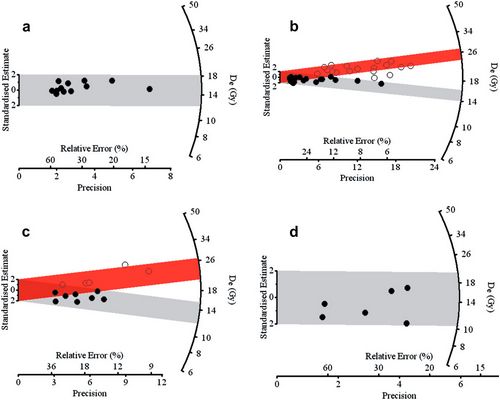
Figure. Radial plot of De values for sample #4. The minimum age model was applied to identify the subpopulation representing the well-bleached samples. And the filled circles in the gray shadow area represent well-bleached grains dominated aliquots used for De value calculation. The unfilled circles represent De values of poorly bleached grains dominated samples. (a) 63–90 mm; (b) 180–250 mm; (c) 250–300 mm; (d) 300–500 mm.(Image by Quaternary Geochronology)
The research of the equivalent dose of different grain size quartz fractions from lakeshore sediments in the arid region of north China was accomplished recently by the researchers of Cold and Arid Regions Environmental and Engineering Research Institute. The researchers investigated the reliability of OSL dating to lakeshore sediments and several lakeshore samples from the north arid region of China were examined. A series of grain size fractions of quartz were separated from each sample and De values were obtained using a standard single aliquot regenerative (SAR) protocol. The relationship between De values and grain size was discussed.The researchers also compared the OSL ages of different grain size fractions from one sample with a radiocarbon age from the same lithologic layer to identify the reliable grain size fraction suitable for OSL dating of lakeshore sediments.
It is claimed that, Equivalent dose (De) values were measured by using medium aliquots of different grain size quartz fractions of five lakeshore sediments from the arid region of north China. There are two different relationships between De values and grain sizes of these five samples. The first relationship is that the De values obtained from various grain sizes are in agreement within 1 delta errors. The second relationship is that De values are similar to each other for fractions between 125 and 300 mm, while the De value of the 63–90 mm fraction is 40w55% smaller than others. For example, the De values obtained for sample #3 are 20.15 _ 1.19 Gy, 19.80 _ 0.83 Gy and 20.93 _ 1.06 Gy for fractions of 90–125, 125–150 and 250–300 mm respectively, but are 10.79 _ 0.84 Gy for the 63–90 mm fraction. The second relationship can’t be interpreted by previous studies of both dosimetry and heterogeneous bleaching. It is deduced for sample #2, #3 and #6 that fine particles (<90 mm) intruded after the dominant sedimentation.Comparison of OSL ages from different grain size fractions of sample #2 with a radiocarbon age from the same lithologic layer supports that fractions coarser than 125 mm yield more reliable burial ages, while the fraction finer than 90 mm yields underestimated ages for some lakeshore sediments from this arid region.
This program was subsidized by National Basic Research Program of China (973 Program) (2009CB421306), National Innovative Research Team Project (40721061), and Grant of National Natural Sciences Foundation of China (40502016 and 40872108).

